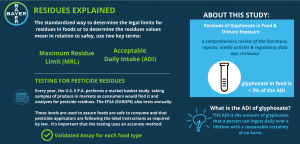Residues of glyphosate in food and dietary exposure
There is considerable information originating from both the scientific literature and media about the detection of glyphosate in the foods we eat, and consequently, in urine. Unfortunately, these reports often come with little context on how the data is obtained or what the reported values mean in terms of safety.
In a study published by John L. Vicini, Pamela K. Jensen, Bruce M. Young, and John T. Swarthout, on the Comprehensive Reviews in Food Science and Food Safety, the authors compiled data from peer-reviewed literature, media reports, non-governmental organizations, and regulatory agencies.
The data was reviewed while considering both the analytical method used and whether the reported values indicate levels of glyphosate that could be harmful to human health.
The study also looked at glyphosate’s Acceptable Daily Intake (ADI)- the amount of glyphosate that a person can ingest daily over a lifetime with a reasonable certainty of no harm.
The study found that when compared to the current ADI, glyphosate exposure through food is less than 3% of the ADI utilized by the European Food Safety Authority (EFSA).
Furthermore, conclusions of risk assessments, based on dietary modelling or urine data, are that exposures to glyphosate from food are well below the amount that can be ingested daily over a lifetime with a reasonable certainty of no harm.
Although peer-review is not a fool proof process, it is a process with the intent of ensuring that results and conclusions from published studies are based on well-conducted and documented scientific experiments. This is in sharp contrast to the essentially unreviewed environment of media and online publications. Since the public does not have training to distinguish information from peer-reviewed journals and science-based regulatory authorities from information they see in media reports and predatory journals, this review has included results on glyphosate residues from both sources to provide them with a single-point reference for an informed discussion of this subject.
See illustration in the infographic below:

Click here to view the image.
These are some quotes from the authors of this review:
JOHN VICINI, Head of Regulatory Technology Safety & Acceptance
“We know that consumers wonder why there are media reports with flashy headlines that seem to break the news that there is glyphosate in their breakfast cereal or even ice cream. But there is no news here. Industry and regulatory scientists collect residue data before new uses of a pesticide. The data then and now indicate a wide margin of safety. We gathered and reviewed reports from media, the scientific literature, regulatory agencies, and NGOs to publish this comprehensive review.”
PAMELA JENSEN, Principal Scientist and Analytical Methods Specialist
“Many reports on detection of glyphosate in the foods we eat provide very little context around how this data is obtained. My goal was to provide an overview of the advantages and disadvantages of the types of assays commonly used for measuring glyphosate and the critical factors in determining whether an assay is fit for its intended purpose. Being able to evaluate the capabilities and limitations of the assay used is essential to assessing the reliability of the reported data. As technology improves, we’re going to be able to detect pesticides at lower and lower levels and so the number of detections will likely increase. But detection does not equate to unsafe. Framing the safety conversation around what does a detection mean, rather than an expectation of zero detection, should be the goal.”
BRUCE YOUNG, Issues Management
“We summarized residue monitoring data from regulatory authorities in Europe, United States and Canada. These market basket studies are based on food sampled at port of entry or foods purchased from the marketplace. The goal of monitoring studies is to ensure that farmers are following the approved label instructions and that residues are not at unexpectedly high levels. Monitoring studies by global regulatory authorities are conducted annually and are completely transparent on how the sample analysis is done. This includes using statistically relevant sample size and validated assays capable of detecting multiple pesticide residues.”
JOHN SWARTHOUT, Issues Management and Outreach
“While using a validated assay and whether Glyphosate is detected or not are both important, the principal thing to consider is not that Glyphosate is being detected, but rather that the values are reported in the proper context as far as dietary safety is concerned. When you look at the totality of the data, the conclusion is clear that acute dietary Exposure to glyphosate does not represent a safety concern.”
Access the full report via this link or click on the image below.
